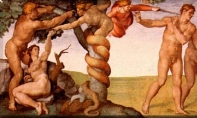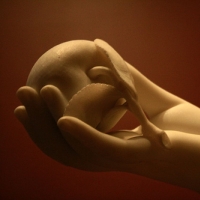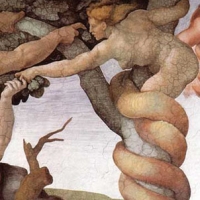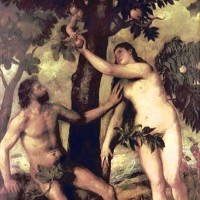- About Us
- Columns
- Letters
- Cartoons
- The Udder Limits
- Archives
- Ezy Reading Archive
- 2024 Cud Archives
- 2023 Cud Archives
- 2022 Cud Archives
- 2021 Cud Archives
- 2020 Cud Archives
- 2015-2019
- 2010-2014
- 2004-2009
 |
The Genesis Myth and Elaine Pagels’ Adam, Eve, and the Serpent |
The traditional understanding we have of the Genesis story in the Old Testament of the Bible consists primarily of the creation of the world in six days and the creation of humanity (Genesis 1:26-2:3): of man, Adam, and then of woman, Eve, out of his side, followed by the fall and expulsion from Paradise upon Eve's succumbing to the serpent's temptations (Genesis 2:4). The account of the fall of Adam and Eve has played an important role over the centuries in the spread of Christianity and in the dissemination of Christian ideology in  general, and though interpretation of the passages has produced various meanings and emphases, there has been, on the whole, a largely 'blind' adherence to these various interpretations in religious circles without any analysis of the origins of the Genesis myth, the sociopolitical context or the motivations and influences of those who were important in laying the foundations for interpretation of the scriptures which we read today. It is this particular aspect of religious history that had not been explored at any considerable length previously until Elaine Pagels' 1988 study Adam, Eve, and the Serpent.1 As Pagels pointed out, over the last twenty or thirty years, the upheaval in social attitudes regarding sexuality and issues such as marriage, divorce, abortion, contraception and gender raised a number of questions which became directed at the secular world,2 and in this sense the Genesis myth, especially regarding the role and significance of Eve, is deserving of study and this is what makes Elaine Pagels' thesis at once both original and relevant for the modern historian.
general, and though interpretation of the passages has produced various meanings and emphases, there has been, on the whole, a largely 'blind' adherence to these various interpretations in religious circles without any analysis of the origins of the Genesis myth, the sociopolitical context or the motivations and influences of those who were important in laying the foundations for interpretation of the scriptures which we read today. It is this particular aspect of religious history that had not been explored at any considerable length previously until Elaine Pagels' 1988 study Adam, Eve, and the Serpent.1 As Pagels pointed out, over the last twenty or thirty years, the upheaval in social attitudes regarding sexuality and issues such as marriage, divorce, abortion, contraception and gender raised a number of questions which became directed at the secular world,2 and in this sense the Genesis myth, especially regarding the role and significance of Eve, is deserving of study and this is what makes Elaine Pagels' thesis at once both original and relevant for the modern historian.
Over the last several centuries, the sexual attitudes which were adopted into the Western world and which are, in many parts of the globe, only being transformed today, were attitudes that owed a great deal to the influence of the Christian movement and, obviously, the manner in which the Genesis account of the fall of Adam and Eve was read (and, certainly still is read today) by the majority of Christian churches, that "... the story of Eve proves both woman's natural weakness and gullibility and defines her present role. Chastened by reminders of Eve's sin, deprived of all authority, women must silently submit to their husbands, grateful that they too may be saved, provided they adhere to their traditional domestic roles."3 As Elaine Pagels emphasizes, however, the traditional interpretation of the story of creation may be far different from its original intention since it has been read so differently since its earliest beginnings.4 The creation account of Adam and Eve, it must be recognized, existed long before the birth of Jesus Christ and was a myth used widely amongst Jews as a means of justifying and proving their own tribal customs and beliefs, and, indeed, their very existence.5 Jewish teachers incorporated traditional practices into their religion by invoking their creation account to set standards for marital behavior and sexual conduct. For example, procreation was given an importance above even the confines of marriage, and divorce was permissible if a wife failed to bear her husband a child within a certain period.6 By Jesus' lifetime, therefore, the creation account already had been written and interpreted with several specific purposes in mind.
 Difficulties arise, however, in that according to the New Testament, Jesus mentioned the story of creation but once during his life, and even then it was only in answer to a question regarding what legitimate grounds there would be for divorce.7 Mathew recounts that Jesus shocked his Jewish listeners by answering that the creation account allowed no legitimate grounds for divorce whatsoever, and that a life of abstinence (and therefore of purity) would be preferable even to marriage and the act of procreation since it would magnify one's dedication towards the work of the Gospel.8
Difficulties arise, however, in that according to the New Testament, Jesus mentioned the story of creation but once during his life, and even then it was only in answer to a question regarding what legitimate grounds there would be for divorce.7 Mathew recounts that Jesus shocked his Jewish listeners by answering that the creation account allowed no legitimate grounds for divorce whatsoever, and that a life of abstinence (and therefore of purity) would be preferable even to marriage and the act of procreation since it would magnify one's dedication towards the work of the Gospel.8
It follows, then, that since Jesus only offered a somewhat limited interpretation of the story of creation that it was to remain subject to further translations and re-definitions well after his death. The disciple Paul expanded even further upon Jesus' message, to preach in favor of religious celibacy,9 however other followers who were more critical of radical asceticism, namely the apostle Mathew and the early Christian father Clement of Alexandria offered far more liberal readings of the creation story and Jesus' interpretation. Pagels uses the example of Mathew 19:9, for instance, which contains Jesus' rejection of divorce: "What God has joined together, let no man put asunder"- with Mathew's modification allowing for divorce- "Whosoever divorces his wife, except for immorality, and marries another, is guilty of adultery."10 Certainly, in these formative years in the development of Christianity - the first four centuries A.D - the movement faced opposition not only from the established Jewish and other religious orders, but from the Roman empire itself, which persecuted thousands who would refuse to sacrifice to the Roman gods and yield to the emperor.11 It is little wonder, then, that preachers and writers of the Christian texts would offer interpretations of the scriptures — in this example the creation myth — which would facilitate the growth of the movement or their own personal following, attracting believers to whom their message had been most appealing. By offering a less restrictive view of such matters as the role of women in Christianity or the scriptures' position on divorce, individuals who may have otherwise been excluded or alienated from the Christian religion were now made welcome. Since their inception, therefore, the scriptures were interpreted by different people in different ways — it is merely that a certain few such interpretations entered the mainstream and produced 'popular'  understandings of what the scriptures had intended, especially after the end of the second century, when the majority of churches accepted as canonical the list of gospels and letters which formed what we recognize today as the New Testament.12
understandings of what the scriptures had intended, especially after the end of the second century, when the majority of churches accepted as canonical the list of gospels and letters which formed what we recognize today as the New Testament.12
Whilst the scriptures were re-interpreted over time to suit various needs and particularly to attract followers, there was never a radical departure from the church's 'official' views on certain matters. Feminine perspectives from the period are rare, but even those that have been found show only a mild departure from the mainstream views of the church, as in Faltonia Betitia Proba's Virgilian poem of the story of creation from the fourth century (although in her poem the curse of female subjection as one of God's penalties for Eve's treachery is not mentioned).13 Further, alternative improvisations on Genesis such as those discovered in 1945 in Nag Hammadi and in the Dead Sea Scrolls were suppressed and largely unknown until their discoveries last century because of the control which Christian leaders and writers had had over specific aspects of definition and meaning in the scriptures, and by expelling nonconformists from their Christian ranks.14 Tatian the Syrian and Tertullian the North African convert, writing in the second and third centuries A.D both maintained an interpretation of Eve's actions that was critical. Tatian equated Eve's treachery with sexual intercourse, arguing that Adam and Eve abandoned their marriage to the Spirit of God when they embarked upon relations with each other that had not originally been intended for them by God.15 Though this view was criticized by theologians such as Clement, who argued that procreation had certainly been a part of God's original intention for humanity, it was a view that was nonetheless espoused by many.16 Tertullian magnified the inequalities for women in this early period by preaching that "... because you destroyed God's image, man", women "... deserve to be judged by men."17 It was views such as these which served to confirm and justify the status of women in the Western world, a status which was cemented by the influential theologian Augustine (354-430 A.D) who, particularly in his later years, emphasized humanity's enslavement to sin which had grown out of Adam and Eve's 'original' sin — that they had sought out, selfishly, to establish their own free will, however a will free of the Lord himself.18 Augustine wrote of women: "What is the difference? Whether it is in a wife or a mother, it is still in Eve (the temptress) that we must beware of in any woman."19
The sum result of such developments and interpretations, particularly after Christianity was no longer a persecuted movement and after the work of Augustine,20 was the institutionalization of Christian codes of behavior and practice for issues of sexuality which we maintain today, though perhaps not nearly as rigidly. Elaine Pagels'  study, using the creation story of Adam and Eve as an illustration, clarifies the way in which subject matter of historical significance (in this case Christian ideology and traditions) can develop over time through varying interpretations. Since the Gospels of the New Testament were originally written, essentially, as a guide to spiritual and moral behavior, as stories from which several lessons could be derived, and since those same Gospels are neither histories nor biographies, there is little to which the modern historian can compare or query accounts, or find an authoritative answer as to the intentions of the original author. In addition, it is also not to be unexpected that various interpretations might flow from an organic and so closely scrutinized document as the Holy Bible. Pagels' message, therefore, if we are in fact to identify one, has been to show the modern historian that so-called accepted 'truths' within the Bible and the Christian tradition are violable.
study, using the creation story of Adam and Eve as an illustration, clarifies the way in which subject matter of historical significance (in this case Christian ideology and traditions) can develop over time through varying interpretations. Since the Gospels of the New Testament were originally written, essentially, as a guide to spiritual and moral behavior, as stories from which several lessons could be derived, and since those same Gospels are neither histories nor biographies, there is little to which the modern historian can compare or query accounts, or find an authoritative answer as to the intentions of the original author. In addition, it is also not to be unexpected that various interpretations might flow from an organic and so closely scrutinized document as the Holy Bible. Pagels' message, therefore, if we are in fact to identify one, has been to show the modern historian that so-called accepted 'truths' within the Bible and the Christian tradition are violable.
Endnotes
- Elaine Pagels, Adam, Eve, and the Serpent, Random House Press, 1988.
- Ibid., p.xvii.
- Ibid., p.24.
- Ibid., p.8. For discussion of the Genesis account see also Werner Keller, The Bible as History, William Morrow and Company, Inc., 1981, pp.388-391.
- That is, they were "... not barbaric or peculiar as their pagan critics charged, but were part of the very structure of the universe itself." As an example, the Book of Jubilees, written some 150 years before the birth of Jesus by a Palestinian Jew, retold the Adam and Eve story to prove, among other things, "... that Jewish customs concerning childbirth and nakedness were not arbitrary or trivial but actually built into human nature from the beginning." Ibid., pp.11-12.
- Ibid., p.13.
- Mathew 19.
- Jesus answered: "Have you not read that he who made them from the beginning made them male and female and said, 'For this reason a man shall leave his father and mother and be joined to his wife, and the two shall become one'? So they are no longer two but one. What therefore God has joined together, let no man put asunder." Ibid., Mathew 19: 4-6. See also Peter Brown, The Body and Society- Men, Women and Sexual Renunciation in Early Christianity, Columbia University Press, 1988, p.41.
- Though even Paul's message may have been taken too literally by some of his followers. Pagels, op.cit., pp.16-17.
- Ibid., p.22.
- Ibid., p.49.
- Ibid., 26.
- Elizabeth A. Clark, Ascetic Piety and Women's Faith, The Edwin Mellen Press, 1986, pp.124-147. See in particular p.132.
- Just as the gnostics were expelled in the first few centuries after the birth of Christ.
- Brown, op.cit., p.93.
- Pagels, op.cit., p.27.
- Gillian Cloke, This Female Man of God- Women and Spiritual Power in the Patristic Age, AD 350-450, Routledge Press, 1995, p.212.
- This was obviously an argument that was also politically expedient, persuading many followers of their 'need' for external government. Pagels, op.cit., p.xxvi, p.99. See also John Romer Testament- The Bible and History, ABC Books, Sydney, 1996, pp.27-29.
- Cloke, op.cit., p.155.
- Pagels, op.cit., p.150.
